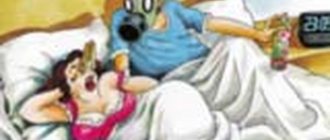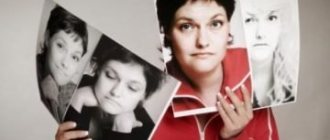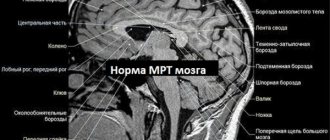Neurological disorders have many forms - from mild ones that even doctors do not notice to extremely severe ones that are life-threatening. Absence epilepsy is a pathology with non-convulsive seizures, which experts classify as benign disorders. This means that the course of the disease is usually mild and responds well to treatment.
Epilepsy with absence seizures occurs mainly in adults and adolescents under 15 years of age, but in adults it can develop due to trauma and some other reasons. The symptoms of the disease are difficult to recognize because attacks, as with other forms, do not occur.
Reasons for violation
Since absence pathology develops mainly in childhood, it is necessary to highlight the causes of the disorder specifically for this group of patients. The most common factor is congenital abnormalities or birth injuries to the brain. Disturbances in deep structures occur mainly in the early stages of pregnancy, but damage occurs in the last trimester. There are several types of diseases and deformities:
- underdeveloped skull;
- disturbances in the functioning and formation of the nervous system;
- dropsy, or hydrocephalus, of the brain;
- endocrine disorders, as well as metabolic problems;
- underdevelopment of parts of the brain that are responsible for reactions of inhibition and excitation;
- traumatic brain injuries;
- acute intoxication resulting from exposure to chemical, biological and radioactive substances.
The last 4 causes of absence epilepsy are considered factors that provoke the disease in later life.
Important! Neoplasms in the brain that occur at any age play a significant role: cysts, tumors, aneurysms.
Mild forms of epilepsy can occur under the influence of factors such as stress, mental and physical fatigue. Hereditary predisposition also matters.
External factors provoking the violation
If you carefully study the mechanisms that trigger epilepsy, you can identify more precise factors. The first place among them is occupied by visual reasons: working at a computer, being engrossed in television or telephone.
Neurological pathology can be provoked by constant exposure to flickering light: garlands, discos. Sometimes the disease is caused by factors such as sudden changes in weather and acute disruption of sleep patterns with constant lack of sleep.
Causes
Absence epilepsy refers to idiopathic forms of the disease, i.e. the reason for it has not been reliably established.
The leading role in development is currently assigned to hereditary mutations, but a single causative gene has not been found.
In patients with different clinical manifestations, different parts of the chromosomes are changed.
As a result, an epileptic focus is formed in a region of the brain, which determines “convulsive readiness.” For the full development of the disease, a combination with risk factors is necessary:
- brain injuries;
- inflammatory diseases of the central nervous system (including those occurring in utero);
- tumor neoplasms of the brain.
Provoking factors that directly trigger attacks are:
- hyperventilation, which causes changes in the ratio of oxygen and carbon dioxide in the blood;
- chronic intoxication with various toxic substances;
- disruption of the content of neurotransmitters in brain neurons;
- increased mental activity;
- stress;
- insomnia;
- rapidly changing visual objects (TV, monitor).
Find out more about epilepsy and its types:
- cryptogenic and generalized;
- idiopathic and myoclonic;
- partial and focal;
- congenital and acquired;
- alcoholic and drug-resistant;
- Kozhevnikovskaya and Jacksonian;
- rolandic and temporal;
- nocturnal and symptomatic.
Common symptoms of epilepsy
Absence seizures are accompanied by certain symptoms, the main one of which is a disturbance of consciousness for 10-20 seconds. Sometimes epilepsy occurs only with this symptom, but most patients have additional signs of a neurological disorder:
- blank stare or blinking with motionless eyes;
- short-term freezing of the patient, cessation of activity;
- interruption and slowing of speech if the patient spoke before the attack.
You can interrupt the attack verbally by addressing the person. After an absence seizure, there is no fatigue or weakness that is characteristic of generalized epilepsy. There is no inhibition or disorientation.
What types of absence seizures are there?
Absence is an epileptic attack characterized by impaired consciousness and absence of convulsions.
At this time, the patient is unconscious, current activities and conversation are interrupted, and he is likened to a motionless statue with a blank look.
Contact is impossible, the patient has no reaction to external stimuli.
This state lasts several tens of seconds (usually 10-20), then he returns to the interrupted activity.
Total amnesia is characteristic; there is no memory of the seizure that just occurred. What is described corresponds to a typical (classical) absence seizure.
In complex absence, motor phenomena are added to the unconscious state, i.e. stereotypical movements characteristic of every patient: smacking lips, twitching certain muscle groups, rolling the eyes, gesturing, throwing back the head, etc.
Sometimes it resembles conscious activity: scratching, trampling. The motor manifestations of a seizure are called components.
With severe absence seizures, relaxation of the body muscles and a person’s fall may occur. After the attack, he can realize what happened.
Features of the course of the disease in adults
In adults, absence seizures rarely occur with impaired consciousness. However, doctors identify many more forms than in children:
- Absence seizures with soft clonic elements. This form is characterized by involuntary contraction of small muscle groups, or twitching of one fiber. An attack begins according to the classic pattern of general signs of epilepsy. However, twitching more often affects the eyelids and corners of the mouth. Attacks can be mild, almost imperceptible, or pronounced. If at this moment the patient is holding any object in his hands, he can throw it.
- Atonic absence. This form of epilepsy is characterized by a sharp reduction in muscle tone: the patient changes his posture, his head is pressed to his chest, in rare cases the disorder causes a fall due to weakness of the muscles in the legs. Hands often drop and the clutch relaxes. But in most cases, atypical absence seizures of the atonic type do not lead to a person falling.
- Tonic absence seizures. This category includes seizures accompanied by tonic contraction of muscles: hypertonicity occurs, flexion and extension movements become frequent, rapid, and affect asymmetric or symmetrical muscles. In this case, the patient experiences acute symptoms of an attack: the head is thrown back, the eyelids twitch, the eyes roll back. The degree of severity depends on the individual characteristics of the person.
- Absence seizures with automatic elements. This category includes seizures associated with goal-directed and quasi-directed movements. This means that a person begins to unconsciously make small movements: biting his lips, waving his arms, pinching clothes, and sometimes walking aimlessly. Automation for atypical absence seizures can be simple or complex. In the simple form, only individual muscles are involved in the pathology, so signs of epilepsy may not be noticed.
- Absence seizures with autonomic disorders. Most often they are accompanied by attacks associated with changes in the skin and some physiological processes: sweating increases, pallor, hyperemia appear, and pupils dilate. In severe cases, the patient experiences enuresis.
There are also mixed forms of absence epilepsy. The severity of these forms can be so strong that a person cannot perform usual activities.
Absence seizures in adults
The disease in question is a mild type of epileptic seizure. However, people who experience signs of absence seizures should monitor their own health more closely. They are advised to try to be alone less, and they should not be alone when swimming or interacting with unsafe technical devices. In addition, individuals suffering from such seizures are prohibited from operating vehicles or other equipment.
Absence, what is it? Mostly, absence seizures are characterized by the following manifestations: immobility of the body, absent gaze, slight fluttering of the eyelids, chewing movements, lip smacking, simultaneous motor acts of the upper limbs.
The described state lasts several seconds. Recovery from absence seizure occurs quickly, the individual returns to his normal state, but is unable to remember the seizure. Often people can experience several attacks per day, which often significantly complicates their professional activities.
Typical signs of absence seizure are absent-mindedness, changes in the color of the dermis, and fluttering of the eyelids. Individuals may experience complex absence seizures, which are accompanied by backward bending of the body and patterned motor acts. After suffering a complex seizure, the individual usually feels that he has experienced something unusual.
The disorder in question is usually systematized according to the severity of its leading manifestations, therefore a distinction is made between typical seizures and atypical absence seizures. The first ones occur in the absence of preliminary signs. The person seems to become stiff, his gaze is fixed in one place, and the motor operations performed before the onset of the seizure stop. After a few seconds, the mental state is completely restored.
The atypical type of absence seizure is characterized by a gradual onset and completion, as well as broader symptoms. An epileptic may experience bending of the body, automatism in motor acts, and things falling out of their hands. Decreased tone often causes a sudden drop in the body.
Complex absence seizure with an atypical course, in turn, can be classified into the 4 forms below.
Myoclonic seizures are characterized by a short partial or complete loss of consciousness, which is accompanied by sharp, cyclic tremors throughout the body. Usually myoclonus occurs bilaterally. More often they are found on the facial area in the form of twitching of the corners of the lips, trembling of the eyelids and eye muscles. An object in the palms falls out during a seizure.
Atonic forms of absence seizure are manifested by a sharp weakening of muscle tone, which is accompanied by a fall. Often, weakness can appear only in the neck muscles, causing the head to fall onto the chest. Rarely, with this type of absence seizure, involuntary urination occurs.
The akinetic form is characterized by a complete shutdown of consciousness along with immobility of the entire body.
Absence seizures that occur with vegetative symptoms manifest themselves in addition to loss of consciousness, urinary incontinence, redness of the dermis of the face, and sharp dilation of the pupils.
Features of epilepsy in children
In children, absence epilepsy often occurs in the following type: the child freezes and does not react to external actions for 10-15 seconds, his eyes look at one point. Some children exhibit blinking movements, others instinctively begin to chew.
Childhood absence seizures last from 10 to 15 seconds, and after returning to normal activity, the child does not even realize what happened to him. Doctors identify several features of seizures in children:
- up to 100 attacks per day;
- the normal process of child development is usually maintained;
- in the presence of several dozen attacks per day, sometimes a lag in studies appears;
- absence seizures often occur during sports;
- a third of young patients have problems with memory and concentration;
- immediately after the start of drug treatment, the number of attacks decreases, cognitive functions normalize.
Among all children suffering from epilepsy, atypical absence seizures occur in approximately 8%. Peak disease activity occurs between ages 3 and 11 years, especially between 5 and 8 years.
At least 2/3 of patients successfully undergo drug therapy, and their attacks disappear by adolescence. However, many continue to have problems with concentration and memory. In 10-15% of children, the consequences of absence epilepsy develop in the form of generalized seizures.
Absence seizures in children
The disorder in question is considered a fairly common symptom of an epileptic seizure. Absence is a form of functional brain disorder that causes a short-term loss of consciousness. An “epileptic” focus arises in the brain, which affects its various areas through electrical impulses, which disrupts its functionality.
Absence is expressed in the form of epileptic seizures, characterized by a sudden onset and abrupt cessation. Upon returning from the attack, the child does not remember what happened to him.
Childhood absence syndrome is manifested by the following symptoms. During a seizure, the baby’s torso becomes motionless and the gaze is absent. At the same time, fluttering of the eyelids, chewing acts, smacking lips, and identical hand movements are observed. The described state is characterized by a duration of several seconds and a similar rapid restoration of functionality. Some children may experience several seizures every day, which complicates normal life activities, complicates educational activities and interaction with peers.
Often parents do not immediately notice the occurrence of such seizures due to their short duration. The first sign of pathology is a decrease in school performance; teachers complain of the appearance of absent-mindedness and loss of the ability to concentrate.
You can suspect the occurrence of absence seizure in a baby by synchronous motor operations with your hands and a detached gaze. In schoolchildren, with a frequency of several seizures per day, disturbances in the psycho-emotional sphere are also noted. Children suffering from absence seizures should always be under the constant supervision of adults, since loss of consciousness can take the baby by surprise, for example, when crossing a busy traffic lane, cycling or swimming.
The consequences of childhood absence seizures are not very serious and often the attacks go away on their own by the age of twenty. However, they can also provoke the development of full-fledged convulsive attacks or accompany the individual throughout his entire existence. In severe cases, absence seizures occur dozens of times a day.
Also, the condition in question is dangerous due to a sudden loss of consciousness, as a result of which the baby can fall and injure himself, or drown if a seizure overtakes him while in the water. In the absence of effective therapeutic intervention, seizures increase, which threatens to impair the intellectual sphere. In addition, the smallest inhabitants of the planet are at risk of social maladjustment.
Separation by form
Additionally, doctors identify typical and atypical absence seizures, which are found in any of the subforms of epilepsy:
- Typical absence seizures. More often observed in generalized idiopathic epilepsy, the EEG during diagnosis shows more than 2.5 Hz.
- Atypical absence seizures. There are several types and develop along with severe symptoms. Accompanied by difficulties in teaching children, they have frequent convulsions: atonic, myoclinic and tonic. The attacks arise and stop gently, not as in the typical course. The EEG will be less than 2.5 Hz.
Doctors may need several rounds of tests to make an accurate diagnosis.
There are also true and false absence seizures. During a false seizure, a person quickly reacts to touch and speech; true absence seizures occur without reacting to external stimuli during the time the attack lasts.
Causes of absence seizures
Absence attacks often go unnoticed, making it difficult to detect the nature of their origin. A number of scientists put forward the hypothesis of a genetic predisposition against the background of the appearance at a certain moment of activation of the functioning of brain cells.
In addition, a distinction is made between a true seizure and a false absence seizure. It is easy to remove the last individual by touch, or treatment, or a loud, sudden cry. If the seizure is true, then the subject will not react to the actions described above.
Also, probable etiological factors for the onset of the condition under consideration include:
- hyperventilation of the lungs, leading to changes in oxygen concentration and carbon dioxide levels, which causes hypoxia;
— intoxication with toxic products;
- violation of the ratio of necessary chemical compounds in the brain.
However, it should be understood that in the presence of all the listed provoking factors, the condition in question does not always develop. The likelihood of absence seizures increases if the subject is diagnosed with one of the following ailments:
— dysfunction of nervous system structures;
- congenital convulsive disorder;
- condition after suffering inflammatory processes occurring in the brain;
- brain contusions, various injuries.
Childhood absence syndrome often occurs as a result of pathologies that arise during the child’s ontogenesis at the genetic level. When a fetus in the mother’s womb experiences changes in the formation of brain structures and the nervous system, which after birth are found in neoplasms, microcephaly or hydrocephalus.
In addition, childhood epileptic absence seizure can arise against the background of a mismatch between inhibitory impulses and excitation signals of the nervous system, which occurs as a result of infectious diseases suffered in infancy or at an early age, hormonal disorders or brain contusions.
The following are typical factors that provoke the onset of absence seizures in babies:
- constantly present stressors;
- increased mental stress;
- increased physical activity;
— adaptation to climate change;
- infectious diseases, brain surgery or trauma;
— there are kidney diseases, pathologies of the myocardium and respiratory system;
- intense strain on vision due to excessive involvement in the computer gaming world, reading or watching colorful cartoons.
Methods for diagnosing the disease
To diagnose absence epilepsy, you need to contact a neurologist. Next, general tests and an electroencephalogram will be prescribed, which takes indicators of brain activity. Prescribing CT and MRI is necessary only if there are suspicions of infectious processes, tumors and other incurable or deadly diseases.
First aid and treatment
Despite the mildness of the form, absence epilepsy requires mandatory medical intervention and treatment. In adults, the most common drug is ethosuximide , as well as valproic acid. Lamotrigine is also used in children
Important! The drugs are taken for a long time according to an individual regimen. If, within 3 years after the start of treatment for absence seizures, seizures no longer recur, doctors consider discontinuing the medications.
First aid for absence seizures is practically not required - they occur in a mild form. If a person becomes ill, you can open the window, free him from tight clothes and lay him on the bed.
Types of absence epilepsy
There are two forms of absence epilepsy – childhood and juvenile forms of the disease, which are classified according to the time of onset of the first signs of the disease (patient’s age).
Absence epilepsy refers to idiopathic epilepsy that occurs when exposed to provoking factors on a hereditarily provoked background. This form of the disease often develops in children who have close or distant relatives with an established diagnosis of epilepsy (2/3 of patients).
Childhood absence form
The childhood absence form occurs more often in girls aged 2 to 8 years and is considered a benign form of the disease. With timely diagnosis and constant use of anticonvulsants, the duration of the disease is on average 6 years with a favorable prognosis and in most cases ends in complete cure or long-term remission up to 18-20 years (70-80% of cases).
Parents need to know the symptoms in order to contact a specialist in a timely manner and begin treatment for the baby.
Absence seizures have characteristic features:
sudden onset against the background of complete health (as a rule, precursors of attacks are very rare, but sometimes they can manifest themselves as headache, nausea, sweating or palpitations, behavior that is not typical for a child (panic, aggression) or various sound, taste or auditory hallucinations);
the attack itself is manifested by symptoms of freezing:
- the child suddenly completely interrupts or slows down his activity - the baby becomes motionless (freezes in one position) with an absent face and a fixed or empty gaze;
- unable to attract the child's attention;
- after the end of the attack, children do not remember anything and continue the movements or conversation they started (symptom of “freezing”).
These attacks are characterized by a deep disturbance of consciousness with its immediate restoration, while the average duration of an attack ranges from 2-3 to 30 seconds.
It is important to remember that very short absence seizures are not felt by the patient, and for a long time they go unnoticed by parents or teachers.
It is important for teachers and parents to know that if performance declines (for no apparent reason) - absent-mindedness in class, deterioration of calligraphy, omissions of text in notebooks - it is necessary to become alarmed and examine the child.
Such symptoms cannot be ignored, much less scold children (without proper treatment, the symptoms will progress, and “minor” forms of epilepsy can be complicated by typical seizures).
Juvenile absence epilepsy
This type of absence epilepsy is characterized by the appearance of absence seizures in adolescence, but unlike the childhood form, the disease is more complex, and attacks are characterized by:
- longer duration (from 3-30 seconds to several minutes);
- varying frequency of occurrence from 10-15 times a day and more often up to 100 times a day;
- high risk of major seizures.
Can external factors provoke seizures? The causes of epilepsy in children are different, but the “debut” of the disease often occurs against the background of:
- frequent stress;
- significant mental or physical stress;
- when there is a change in climate and place of residence, which is often associated with a violation of the adaptation mechanisms of the child’s central nervous system;
- after injuries, operations, intoxications (poisoning, influenza or other viral and bacterial infections);
- for endocrine pathology, metabolic disorders, against the background of progression of somatic diseases (pathology of the kidneys, liver, heart, respiratory system).
A seizure can be triggered by: - large visual loads (long reading, watching TV, computer games), cartoons, games or programs with frequent changes of bright pictures, blinking and flashing on the screen are of particular importance;
- bright light or its flickering (light music at discos, New Year's garlands);
- increased physical activity;
- overwork (high mental stress);
- lack of sleep or excess sleep;
- a sharp change in barometric pressure, temperature and air humidity.
Adults often ignore absence seizures, considering them an individual feature of the child’s character - thoughtfulness or distraction. But absence seizures are the main and specific symptom of childhood epilepsy, which is a serious chronic pathology of the nervous system and requires urgent mandatory treatment.
You can read about the features of treating epilepsy in children in this article:
Treatment of epilepsy in children - what you need to know about it
pediatrician Sazonova Olga Ivanovna
Save
Article read: 1,237
Possible complications and consequences in childhood
If absence epilepsy has been diagnosed and doctors have prescribed adequate treatment, then in 80% of cases the disease disappears by 10-15 years. More precisely, attacks and additional symptoms of the disease disappear. But the risk of relapse in adulthood remains. In this case, the disease takes on a severe form, becomes generalized, and the patient experiences seizures and convulsions.
Absence epilepsy in most cases does not affect the psyche and does not lead to severe disorders. Maximum consequences: learning difficulties, absent-mindedness, difficulty concentrating and increased excitability. Absence seizures are often confused with hyperactivity. However, after a professional examination, the confusion completely disappears.
Age characteristics
Absence has a number of differences in adults and children. In childhood, this condition is classified as mild epilepsy. It is observed in 15–20% of children and is first diagnosed no earlier than 4 years of age. During an attack, all characteristic symptoms are noted (detachment, lack of response to stimuli, lack of memory of the attack), and then the child returns to normal activities. The danger is that an attack can occur while swimming or crossing the road. Children with these symptoms should always be kept in the sight of adults. With absence seizures, visiting school, college and other educational institutions can cause problems.
Absence attacks in children are usually short-lived and do not attract the attention of others. But they can provoke a decrease in performance during lessons and absent-mindedness. If automatic actions are performed during an attack, it is necessary to consult a specialist, since there is a high risk of absence seizure becoming a type of epilepsy.
Absence seizures in adults occur in only 5% of the population. And although the duration of the attack at this age is shorter, it poses no less danger. Such people should not drive a car, use potentially life-threatening equipment, or swim or swim alone. Carrying out job responsibilities can be a challenge. In adults, absence seizures are often accompanied by essential head tremors, which leads to loss of coordination and fainting. Hand tremors are also possible.
Prognosis and prevention
The course of absence epilepsy is favorable in most cases, remission occurs on average in 85% of patients. In children, this figure increases to 90-95%. At the same time, simple absence seizures are more treatable than complex ones.
If motor elements of the disease are added to the attacks, then correction requires more serious measures. In most cases, they can be corrected by introducing a combination of drugs for the treatment of epilepsy. People who have gotten rid of absence pathology should remember about constant relapse prevention:
- it is necessary to adhere to the daily routine, avoid changing the time of sleep and wakefulness;
- you need to limit the intake of stimulant drugs and drinks, food as much as possible: chocolate, caffeine, tea, carbonated drinks;
- in the future, work and human activity should not be associated with acute stress, extreme sports, or stress;
- physical, mental and psychological stress should be moderate;
- physical activity should be light to moderate: yoga, swimming, cycling. Professional sports are contraindicated;
- loud sounds, flashes of light, bright pictures and any flickering with constant exposure often provoke a severe form of epilepsy. Therefore, teenagers and young people should refrain from visiting clubs and discos.
Absence epilepsy is easy to treat in most cases, but people should be mindful of the risks of relapse. This is where the main danger lies, because in the case of repeated epilepsy it becomes more severe and the symptoms are less amenable to correction. This is why it is so important to lead a healthy lifestyle and eat well.










